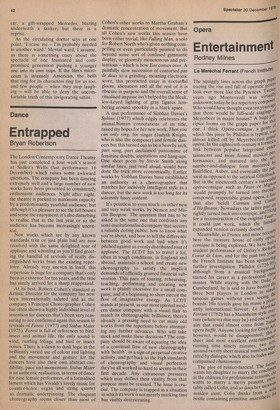Dance
Entrapped
Bryan Robertson
The London Contemporary Dance Theatre has just completed a four week's season at Sadler's Wells (last performance 16 December) which raises some awkward questions. The company has been dancing extremely well and a large number of new works have been presented to consistently enthusiastic audiences. Night after night, the theatre is packed to maximum capacity by a predominantly youthful audience, but although it's a pleasure to see the full houses and sense the enjoyment, it's also disturbing to realise that in the last year or so the audience has become increasingly uncritical.
New works which are by any known standards trite or just plain bad are now received with the same delighted roar of applause and whistling as you'll find greeting the handful of revivals of really distinguished works from the existing repertoire. Already very uneven in itself, this repertoire is huge for a company that's only been in existence for ten years, and the time has surely arrived for a sharp reappraisal.
At its best, Robert Cohen's standard as Artistic Director for the company has now been internationally saluted and as the company's Principal Choreographer Cohen has often shown a highly individual level of invention for dancers that's been very reassuring to see confirmed again this season in revivals of Forest (1977) and Stabat Mater (1975). Forest is full of references to bird, insect and animal life; the only sound is wind, rustling foliage and bird or insect noises. There is a dawn to dusk logic in the brilliantly varied use of colour and lighting and the movement and gesture for the dancers have also their own abstract credibility, pace and momentum. Stabat Mater is an authentic realisation, in terms of dance for nine female performers, of a formalised lament which has Vivaldi's lovely music for counter-tenor, organ and string quartet as dramatic underpinning. The eloquent choreography seems closer than most of Cohen's other works to Martha Graham's dramatic concentration of movement. But all Cohen's new works this season have been either trivial, like Falling Man, a solo for Robert North who's given nothing compelling or even particularly pointed to do beyond some sort of confused gymnastic display, or gloomily monotonous and pretentious — which is how Eos comes over. A painfully slow succession of contorted pas de deux to a grinding, moaning electronic score, this protracted essay in nocturdal gloom, alienation and all the rest of it is obscure in purpose and the overall sense of ritualised impasse isn't helped by the bleak, low-keyed lighting of gray figures lumbering around spookily in a black space.
A taut performance of Siobhan Davies's Sphinx (1977) which edgily celebrates the animal /human connotations of its title, raised my hopes for her new work, Then you can only sing, for singer (Judyth Knight, who is also the composer) and female dancers but this turned out to be a heavily arch, part sung, part declaimed pantomime of feminine doubts, aspirations and hang-ups. One short poem by Stevie Smith, along similar lines, just read aloud, would have done the trick more economically. Earlier works by Siobhan Davies have established an authority as a choreographer that matches her incisively intelligent style as a dancer, but the new work is too long for its solemnly fussy content.
It's pointless to even touch on other new and very weak works, by Nemon and Mischa Beogese. The question that has to be asked is the same one that confronts any semi-institutionalised company that secures a reliably doting public: how to know what you're about, and how to tell the difference between good work and bad when it's pitched against an evenly distributed roar of applause. The LCDT has to travel a lot, often in tough conditions, in England and abroad, maintain a school, and create new choreography to satisfy the implicit demands of officially granted financial subvention. This pace of touring, rehearsing, teaching, performing and creating new work is plainly excessive for a small company, and it's beginning to short circuit the flow of imaginative energy. As LCDT stands at present, as our most spirited modem dance company with a visual flair to match its choreographic brilliance, there's already a pressing need to cut many old works from the repertoire before attempting any further advances. Who will take stock and make these decisions? The company should be aware of equating the idea of a continual flow of new choreography with 'health', as a sign of perpetual creative activity, and get back to the 1-igh standards of choreography and visual perfection they've all worked so hard to secure in their first decade. Any extraneous pressures which may deflect their vitality from that purpose must be resisted. The issue is crucial. The company is trapped in a situation in which its work is not merely marking time but visibly deteriorating.






















































 Previous page
Previous page